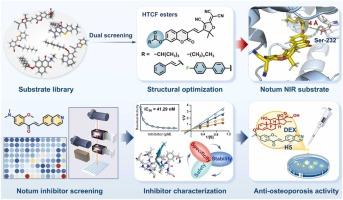Rational engineering of an optimized near-infrared fluorogenic sensor for efficient discovery of potent Notum inhibitors as anti-osteoporosis agents
IF 8
1区 化学
Q1 CHEMISTRY, ANALYTICAL
引用次数: 0
Abstract
Notum, an important member of the serine hydrolase superfamily, acts as a key negative feedback regulator of the Wnt signaling. Inhibiting Notum activity has emerged as a feasible therapeutic strategy for treating osteoporosis (OP) via activating Wnt/β-catenin signaling. This work aimed to develop a high-performance near-infrared (NIR) fluorogenic sensor for high-throughput screening and characterization of anti-Notum agents. First, a dual-driven strategy combining computer-aided molecular design with enzymatic phenotyping assays was utilized to identify an NIR fluorogenic scaffold (HTCF) for engineering Notum substrates. A suite of HTCF esters were then synthesized, while HX-HTCF (the n-hexanoate ester of HTCF) was selected as an optimum substrate for Notum owing to its desirable NIR emission, rapid response, superior signal-to-noise ratio, ultrahigh sensitivity, and high affinity. HX-HTCF was subsequently used to construct a fluorescence-based biochemical assay for the highly efficient discovery of Notum inhibitors. H5 was identified as a novel potent Notum inhibitor, which strongly inhibited Notum-catalyzed HX-HTCF hydrolysis in a competitive manner. Further investigations showed that H5 significantly activated Wnt/β-catenin signaling and promoted osteoblast differentiation in dexamethasone-induced MC3T3-E1 osteoblasts. Collectively, this study devises a practical Notum-activatable NIR fluorogenic sensor, which immensely facilitates the discovery of Notum inhibitors as novel anti-osteoporosis agents.

求助全文
约1分钟内获得全文
求助全文
来源期刊

Sensors and Actuators B: Chemical
工程技术-电化学
CiteScore
14.60
自引率
11.90%
发文量
1776
审稿时长
3.2 months
期刊介绍:
Sensors & Actuators, B: Chemical is an international journal focused on the research and development of chemical transducers. It covers chemical sensors and biosensors, chemical actuators, and analytical microsystems. The journal is interdisciplinary, aiming to publish original works showcasing substantial advancements beyond the current state of the art in these fields, with practical applicability to solving meaningful analytical problems. Review articles are accepted by invitation from an Editor of the journal.
 求助内容:
求助内容: 应助结果提醒方式:
应助结果提醒方式:


